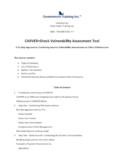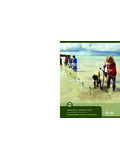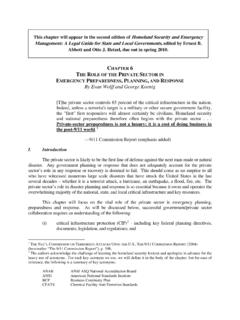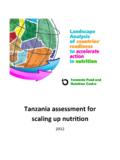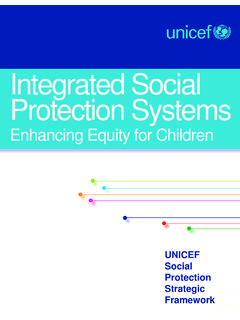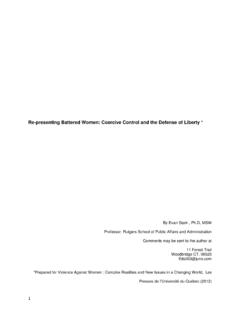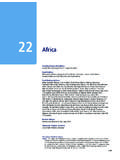Transcription of GOVERNMENT OF PUNTLAND SOMALIA - 日本紛争予防 ...
1 PUNTLAND DISASTER MANAGEMENT FRAMEWORK GOVERNMENT OF PUNTLAND SOMALIA FUNDED BY OCHA IMPLEMENTED BY HADMA & DIAKONIA SWEDEN JUNE 20112 | Page TABLE OF CONTENTS ACKNWLEGEMENT 3 EXECUTIVE SUMMARY 4 INTRODUCTION 6 SECTION I: DISASTER HAZARDS IN PUNTLAND 8 PUNTLAND Hazards 8 Underlying Vulnerabilities 9 SECTION II: PUNTLAND DISASTER MANAGEMENT FRAMEWORK 10 Justification of the Framework 10 Framework Vision 11 Framework Goal 11 Guiding Principles 11 Key Stakeholders 12 SECTION III: PRIORITY AREAS FOR ACTION 12 Expected Outcomes 15 Priority Target Groups 15 SECTION IV.
2 IMPLEMENTATION STRATEGIES 15 Financing and Partnerships 15 Communication Strategy 16 Monitoring and Evaluation Strategy 17 PUNTLAND Emergency Strategy 17 Challenges 17 ANNEXES I-VIII 18 25 3 | Page ACKNOWLEDGEMENT The consultant acknowledges the immense support including information and logistics provided to him during this consultancy period by the Humanitarian Affairs and Disaster Management Agency (HADMA) and Diakonia Sweden in PUNTLAND . Special thanks go to UNOCHA for their advice and financial contribution to the project.
3 I want acknowledge the support provided by the HADMA staff during the research and development of the document. Their information helped me to put my ideas in real context and perspective. My special appreciation is for the Diakonia Sweden who offered me this valuable opportunity to develop the PUNTLAND Disaster Management Policy. Abdirisak Mohamed Ali, Horn Development and Consultants Firm Mobile: +25290727275 Email: The document should be cited in this way: HADMA, 2011: PUNTLAND Disaster Management Framework 4 | Page Executive Summary PUNTLAND is prone to disastrous events of both natural and anthropogenic origin which have caused losses of livelihoods and property that pushed many Puntlanders into poverty.
4 The economic impact of disasters usually consists of direct damage infrastructure, livestock, environment and indirect damage loss of revenues, unemployment and market destabilization. It is therefore increasingly becoming a major developmental issue of urgent concern for the GOVERNMENT , development partners and local communities. PUNTLAND is vulnerable to disaster risks from a range of natural hazards including cyclones/ storms, droughts, epidemics, floods, pest attacks, desertification, and tsunami. Human induced hazards that threaten the country include transport accidents, urban fires, civil conflicts and internal displacements of communities due to multiple factors.
5 High priority hazards in terms of their frequency and scale of impact are: droughts, floods, civil conflict and transport accidents that have caused widespread damages and losses in the past. A number of factors lay behind vulnerabilities of PUNTLAND society to hazards. These include risky construction practices, poor livestock management practices, underdeveloped road infrastructure, fragile natural environment and poverty. The increasing human and animal population, environmental degradation resulting from poorly managed water development schemes and excessive tree cutting, climate change and variability are major dynamic pressures that aggravate vulnerabilities of PUNTLAND society.
6 A reactive emergency response approach has remained the predominant way of dealing with disasters in PUNTLAND till now. The awareness and coordination of policy makers, media, civil society, NGOs, UN agencies and other stakeholders remains low about disaster risk management. The country still lacks operational disaster management policy, legal and appropriate institutional arrangements, strategies and programmes to minimize risks and vulnerabilities. The PUNTLAND Disaster Preparedness and Management Framework have been formulated to guide the work of entire system in the area of disaster risk management.
7 It has been developed through consultations with stakeholders and beneficiaries. The Framework envisions, Achieving sustainable social, economic and environmental development in PUNTLAND through reducing risks and vulnerabilities, particularly those of the poor and marginalized groups, and by effectively responding to and recovering from disaster impact . Eight priority areas identified to establish and strengthen policies, institutions and capacities over the next ten years include: Institutional, legislative and policy frameworks 5 | Page Hazard, vulnerability and risk assessments Early warning systems Mitigation & integration of disaster risk reduction in development sectors Disaster preparedness plans Public awareness and education Capacity development Communication and transportation Roles and responsibilities of key PUNTLAND .
8 Regional and local stakeholders have been defined in the framework. Broadly speaking, all stakeholders are expected to undertake actions to promote disaster risk management as following: Integrate risk assessment in the planning and design stages of all new developmental projects Assess and map vulnerability of people, infrastructure, assets and services related to their sector Develop disaster preparedness and management plans Integrate vulnerability reduction measures in new constructions such as schools, hospitals etc. Develop technical capacities of their departments/sectors to implement disaster risk management strategies, and Allocate funds for disaster risk management in annual development budgets and in sectoral projects.
9 The framework comes at a time when the process of formulation of the forthcoming Five-Year Development Plan (2012-2016) is also likely to commence shortly and it is hoped that the agenda of disaster risk management highlighted in this document would find due reflection in the formulation of development proposals for the coming years. The proposed Framework embodies a vision and is hence thematic in character and outline the emerging challenges ahead and would need to be converted into sectoral work plans, strategies, policies and instruments to achieve its desired outcome for the overall well-being of people and sustainability of the development process in PUNTLAND .
10 6 | Page INTRODUCTION A disaster is a natural or man-made event that negatively affects life, property, livelihood or industry often resulting in permanent changes to human societies, ecosystems and environment. In the international context, disasters mean a serious disruption of the functioning of a community or a society causing widespread human, material, economic or environmental losses which exceed the ability of the affected community or society to cope using its own resources. The DFID Policy Paper entitled Reducing the Risk of Disaster-Helping to Achieve Sustainable Poverty Reduction in a Vulnerable World has ranked the SOMALIA 15th among the developing countries at high risk of disaster.
